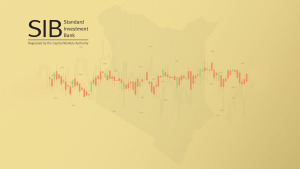Approach Markets with Humility
WESLEY MANAMBO
wmanambo@sib.co.ke
STELLAH SWAKEI
sswakei@sib.co.ke
ERIC MUSAU
emusau@sib.co.ke
Executive Summary
While it’s too early to postulate about a robust 2024 for Kenya, some green shoots are emerging.
Currency appreciation seems somewhat restored; soft commodity prices have moderated while energy prices have been reviewed downwards in the most recent monthly calculation. While interest rates on the domestic front remain elevated, the resolution of the Eurobond issuance seems to have calmed markets.
- Default Speculation off the Table as Kenya reissues the Eurobond: Despite concerns by the investor community over a potential default on the Eurobond mirroring some of the other sub-Saharan countries, Kenya seems to have escaped the concerns in good time, refinancing 72.3% of the maturing 2024 issuance.
- Eurobond Repayment Outlook lenient on Amortized Redemption Structures: Kenya’s financial landscape has been closely scrutinized in light of its Eurobond repayment obligations, particularly with maturities looming consecutively up to 2032. Despite this apparent challenge, Kenya finds itself in a relatively favorable position, largely attributed to the amortized redemption structure embedded within its Eurobond framework.
- Short-term Papers keep the Crown: On government securities, the demand for the 91-day Treasury Bills and short-tenor infrastructure bonds is expected to remain significant throughout the year, reflecting investors’ desire to secure favorable rates as the government aims to align its near-term borrowing objectives.
- On equities, Buy Quality; Patience will be Rewarded: In local public equities, we anticipate an upward reversal in 2024 (likely in 2H24) on the back of fundamentals remaining relatively strong across key sectors and discounted price levels on blue chips reverting upwards toward their median.
- Shilling Performance: Sustained Strength requires more than Surface Gains: Despite the recent strengthening, the shilling is anticipated to encounter strain due to persistent demand for hard currencies amid limited supply. Nonetheless, we foresee a lesser degree of depreciation compared to the notable decline witnessed in 2023. In the near term, we anticipate an augmentation of the dollar inflows but we maintain our stance that, although diminished, risks lie on the downside and the underlying fundamentals do not justify an overly sustained strengthening of the shilling.
- Déjà vu: Currency & Interest Rate Volatility Mirrors 2011–2012: While the Kenyan shilling has seen its fair share of outlier volatility over the years, the most recent activities are reminiscent of the tumultuous periods of 2011 and 2012. This has been reenacted again in 2024, with the MPC raising interest rates in almost a similar playbook to what it did a decade ago.
- Navigating Revenue Targets: Close, but No Bullseye: Cumulative tax revenues for the first seven months of FY 23/24 amounted to KES 1,216.42bn, constituting 48.7% of the target estimates of KES 2,495.83bn and 83.6% of the prorated target of KES 1,455.90. our preliminary analysis indicates a consistent uptick in revenue collections during the final four months of the fiscal years, notably in June. However, the anticipated growth appears insufficient to meet the established targets.
- Embrace Cautious Optimism in Global Assets: We believe investors are overly optimistic about the 2024 global market performance, in part due to the upward revision of estimates following a surprise performance in 2023. The need for caveat emptor in the 2024 investment landscape cannot be overemphasized, as a mix of persistent headwinds will present investors with new uncertainties and uncommon opportunities.
Key Themes
Déjà vu: Currency & Interest Rate Volatility Mirrors 2011-2012
While the Kenyan shilling has seen its fair share of outlier volatility over the years, the tumultuous periods of 2011 and 2012 remain etched in memory. Towards the tail end of 2011 and early 2012, sharp swings in the shilling’s value sent shockwaves through trade and everyday transactions. Fast forward to the dawn of February 2024, and déjà vu sets in as echoes of this volatility resurface, reigniting conversations and concerns about the stability of the Kenyan shilling. Amidst numerous developments, the shilling finds itself at the center of attention once more, stunning observers with an unprecedented 5% single-day surge against the dollar—a feat not witnessed in recent memory. Regulatory actions also seem to have been erringly similar, with higher rates used to calm markets. Will we see another decade of calm after this?
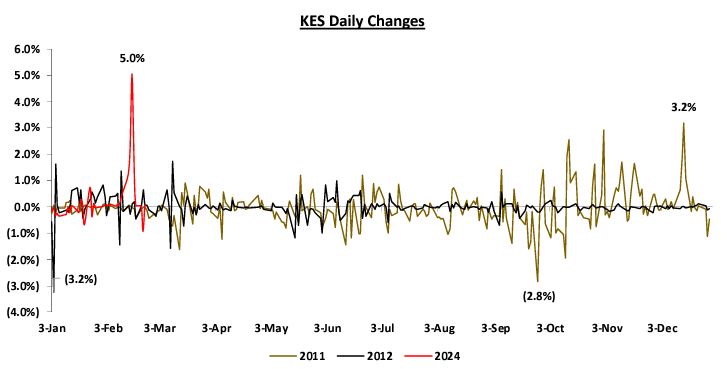
The Central Bank Rate mirrors similar patterns, reminiscent of the period between November 2011 and July 2012. During this time frame, the benchmark rate reached its highest levels (of 18%), strategically deployed to anchor inflationary pressures stemming from the accelerated growth of private sector credit and exchange rate volatility. Pointing up to the hindquarter of 2023 and now 2024, history seems to repeat itself. Once again, the central bank’s benchmark rate emerges as a critical player in the economic landscape, as policymakers seek to navigate the challenges posed by exchange rate related inflation. While the current rate does not reach the zenith recorded during the aforementioned periods, it nevertheless marks an eleven-year high, reminiscent of levels observed in September 2012. It is noteworthy that following a period of enhanced stability within the foreign exchange (FX) market characterized by a reduced level of volatility, the Central Bank of Kenya initiated a series of rate cuts.
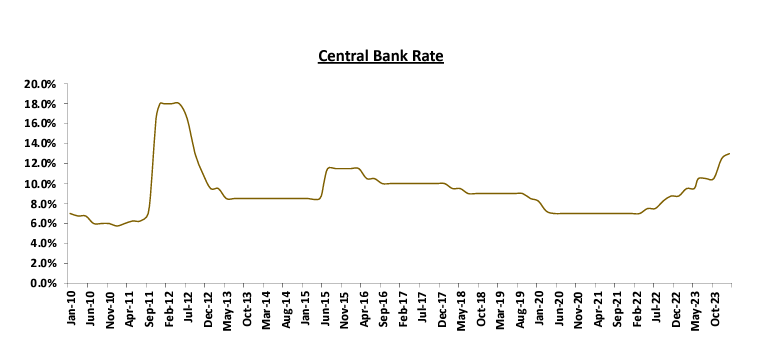
Short-term risks were subsequently reflected in the yields on government securities, which saw the yield curve invert in the 4Q11 but the phenomenon was corrected within 2Q12, after which the rate was revised downwards. Looking ahead, a similar inversion of the yield curve recurred during the second quarter of 2023, yet short-term yields persist below those observed in 2011.
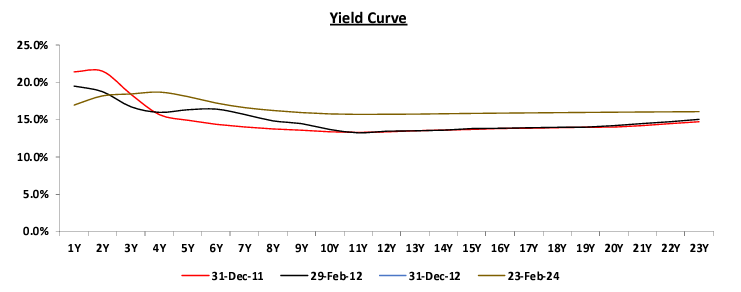
Nevertheless, recent developments suggest a potential normalization of the yield curve as the government resumes the issuance of long-term securities and as short-term risks abate.
Default off the Table: A Prayer Answered
In November 2023, we issued a report: On a wing and a prayer; Kenya’s Public Debt. Kenya faced heightened scrutiny and jitters among investors regarding the possibility of defaulting on its single largest Eurobond obligation. Economic uncertainties, fiscal challenges, and global market volatilities contributed to apprehensions surrounding the nation’s ability to meet its debt obligations. But Kenya, like a seasoned dancer, stepped onto the floor with a plan – the National Treasury orchestrated a strategic move which involved issuing a new note and using the proceeds to buyback a portion of the 10-year paper maturing in June 2024. The success of the new issuance was resounding, as the Treasury effectively repurchased USD 1.44 billion worth of the 2014 Eurobond, accounting for an impressive 72.3% of the principal – A prayer answered.
The strategic maneuver left a positive imprint on both global and local investors, as demonstrated by the remarkable performance of the February infrastructure bond, the shilling’s spirited ascent, and the striking plunge in yields across existing Eurobonds.
Our View:
Buyback: a prudent debt management strategy that eased repayment pressures, improved investor confidence and partly enhanced debt sustainability metrics. Repurchase at par value and including the interest accrued up to the settlement date served the interests of both investors and the government
New Issuance: At prevailing rates, the timing of a new Eurobond issuance warranted scrutiny. We had pinned our hopes on significant financing from multilateral lenders, which would have cushioned the cost of debt obligations. While additional funds would still come through, these may well be used to buffer the reserves, essentially calming market concerns completely. Diaspora remittances for 2024 have also been particularly robust.
We, however, acknowledge the persistent budget deficit, which may have put pressure on the government to find an alternative way to meet the debt obligation without compromising other critical commitments.
Eurobond Repayment Outlook: Leveraging Amortized Redemption Structure
Kenya’s financial landscape has been closely scrutinized in light of its Eurobond repayment obligations, particularly with maturities looming consecutively up to 2032. Despite this apparent challenge, Kenya finds itself in a relatively favorable position, largely attributed to the amortized redemption structure embedded within its Eurobond framework. This systematic approach helps to spread out repayment burdens and mitigate the impact of large principal repayments upon maturity.

Despite maturities occurring every other year from 2024 up to 2032, Kenya does not face extreme repayment pressures, underscoring the effectiveness of its new debt management strategy.
Navigating Revenue Targets: Chasing a Mirage
Cumulative tax revenues for the first seven months of FY 23/24 amounted to KES 1,216.42bn, constituting 48.7% of the target estimates of KES 2,495.83bn and 83.6% of the prorated target of KES 1,455.90. Notwithstanding fervent attempts, technical and political realities have limited achievement of higher targets despite consistent growth. See below a visual representation:
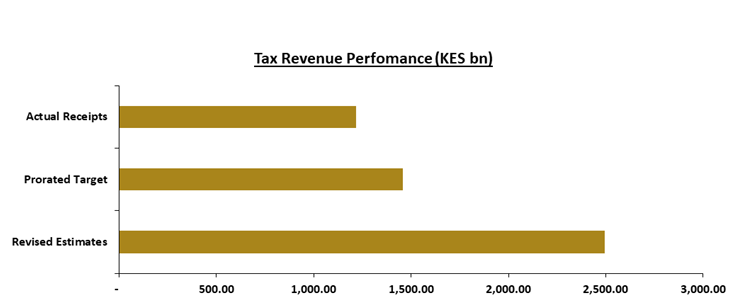
At the current run rate, it is unlikely that tax revenues for FY 23/24 will align with the revised targets; we anticipate a performance ranging between 85% and 90%. However, our preliminary analysis indicates a consistent uptick in revenue collections during the final four months of the fiscal years, notably in June. Even with a robust finishing kick, we still see this as likely to be insufficient to meet the established targets.
Tax-to-GDP Ratio: Taxing the bottom of the pyramid proves a challenge
While Kenya’s tax revenues follow an upward trajectory, tax-to-GDP has been declining since 2014. During this period, the country’s GDP was rebased twice; in 2014 and 2021. With each rebasing, Kenya’s economy expanded, outpacing revenue growth. Taxing the bottom of the pyramid has proved challenging despite GDP contribution.
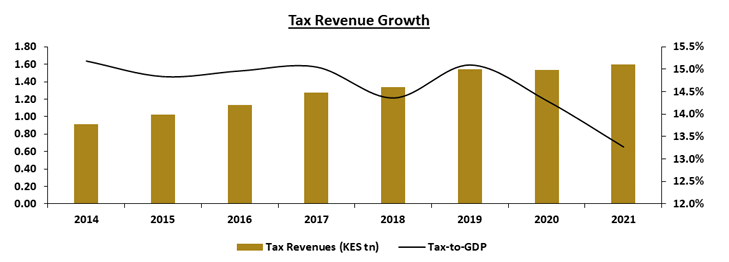
We believe that the decline in the tax-to-GDP ratio is primarily attributable to the faster growth of GDP, factoring in the rebasing, rather than a decrease in tax revenues, as collections have increased every other year except for 2020, which had COVID-related reliefs.
2023 Kenya Asset Performance Survey Recap
In hindsight… the apple didn’t fall far from the tree.
In 2023, we carried out a survey among Kenyan institutions to gauge economic and investment environment sentiments for the year. The survey was anonymous to ensure respondents’ confidentiality and all respondents consented to participation. Our respondents were mainly from capital markets and a few from commercial banking. We have looked back at the survey outlook against how markets panned out and summarized the findings.
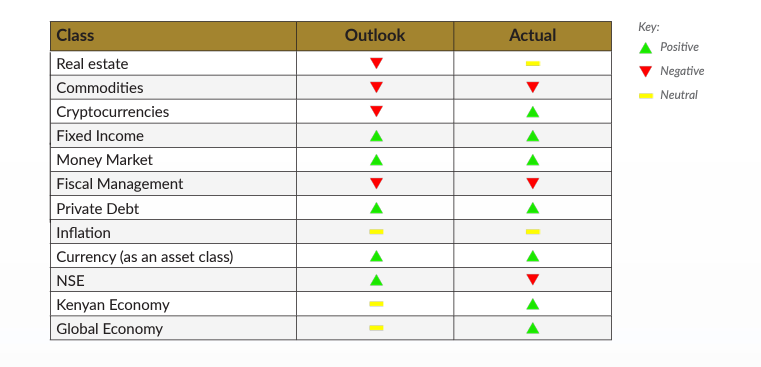
Our Outlook in a Nutshell
| Indicator | Our Expectation |
| GDP – Kenya’s growth story unfolds, guided by the green shoots of a rejuvenated agriculture & Services Sector | Economic growth in 2024 will be largely supported by resurgence in the agriculture sector fueled by spillovers from 2023’s bountiful harvest and expectations of favorable weather conditions in the short and long rain seasons of 2024. Services have also been an important growth driver, and we expect this to continue into 2024 |
| Private Sector Business Environment – Private Sector Grapples with Subdued Outlook Amid Price Pressures | The latest Purchasing Managers’ Index survey indicates heightened caution regarding private sector expansion, with 94% of participants abstaining from forecasting increased activity over the next year. This trend is attributed to escalating uncertainties surrounding: i) The tax environment – With the Finance Act 2024 pending, businesses face uncertainty regarding potential tax adjustments for instance, the proposal to have multiple VAT rates in place. ii) Foreign Exchange: Despite the recent strengthening of the shilling, businesses harbor skepticism about the sustainability of the rally, which could lead to increased input prices in the event of a sudden depreciation. iii) Elevated electricity and fuel prices: The persistence of high electricity and fuel prices adds pressure on businesses, impacting operational costs. We expect an improvement in private sector business in 2024, albeit with downward risks. We note that fuel and energy prices are falling with a stronger exchange rate. Furthermore, there is a burgeoning utilization of hydro and other renewable energy sources, such as geothermal and solar, facilitating a reduction in input costs and consequently mitigating output prices. |
| Consumer Prices – Inflation set to dance to a lower tune in 2024 | We expect the average y/y inflation for 2024 to come in at 6.0%–6.3%, based on stable food prices and a relatively higher base in the first half of the comparison period. On the other hand, fuel inflation is expected to remain sticky in 2024 due to higher import costs and electricity tariffs, although a stronger currency may help. Nonetheless, the probability of a significant surge in consumer prices is limited, given the pass-through effects from preceding and ongoing decreases in energy prices, coupled with a vigilant monetary policy. |
| Currency Expectations: Calm amidst Turbulence | We expect the shilling to encounter relief as pressure points gradually unwind. In addition, supply of dollars has improved in 2024, with multilateral and syndicate lenders channeling significant financing to Kenya, dollar hoarders selling in panic and foreign investor sentiment improving. We opine that the phenomenon is a behavioral economics play as the underlying fundamentals do not support an overly sustained appreciation of the shilling; the current account remains a deficit and debt repayment pressures persist, albeit reduced. |
| Monetary Policy Space a. Central Bank Base Rate; Pivoting towards rate cuts? b. Money Market Liquidity – Charting the Course through Tight Liquidity: Clearer Waters on the Horizon | We foresee the Monetary Policy Committee reducing rates in the second half of 2024, in tandem with other economies, particularly advanced ones, with the aims of fostering economic expansion. We anticipate continued tight liquidity conditions, gradually improving towards the end of the year as banks continue to align with the mandate for interbank rates to closely track the Central Bank Rate. Consequently, we expect Open Market Operations to maintain an active role throughout the year, with the objective of providing support to entities experiencing liquidity constraints. |
Optimism Meets Caution; Downside Risks to the Outlook
i. Potential fluctuations in weather conditions may adversely affect the agriculture sector, as well as delay in fertilizer distribution, which may result in diminished yields and reduced proceeds for goods,
ii. Weak demand, stemming from constrained pockets, may compel consumers to focus only on essential commodities, leading to a decline in demand for durables,
iii. The financial sector may experience an uptick in non-performing loans due to higher interest rates as well as pending bills by national and county governments,
iv. Complex compliance dynamics could contribute to the proliferation of illicit goods, particularly in the alcoholic beverage and nicotine industry, thereby reducing revenue and taxes, and,
v. Elevated construction costs, attributed to higher financing costs, and increases on import-related commodities, and government led affordable housing scheme are expected to reduce the attractiveness of the sector.
vi. Volatile Exchange Rate: Volatility in exchange rates makes it challenging for businesses to plan and forecast future expenses and revenues. In addition, fluctuations in currency values make it difficult to predict costs for imported goods and services, impacting profit margins and competitiveness.
Fixed Income: A record KES 556bn raised domestically in the first two months
Government Securities Market – 91-day Paper Keeps its Crown
In 2024, we anticipate sustained interest in the primary market for both Treasury Bills and bonds due to the prevailing high interest rates. Notably, all primary issuances demonstrate a consistent trend of increasing weighted average rates, irrespective of the bond’s tenor or type. The demand for the 91-day Treasury Bills and short-tenor infrastructure bonds is projected to remain significant throughout the year, reflecting investors’ desire to secure favorable rates as the government aims to align its borrowing objectives. See below the chart showing the subscription rates for the 91-day paper since January 2023;
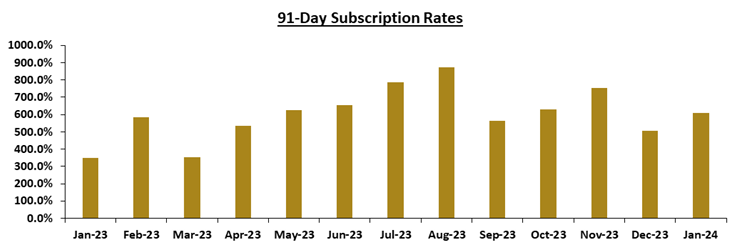
Conversely, the secondary market is anticipated to remain subdued, as investors are inclined to retain their bonds to mitigate potential mark-to-market losses.
Interest Rates: Yield Curve Holds Fast Amid Limited Long-Term Supply
The yield curve is anticipated to maintain an inverted shape throughout a significant portion of the year, with short-term paper yields rising at a faster pace compared to long-term paper yields. This outlook is influenced by two primary factors:
i) Limited availability of long-term papers in both primary and secondary markets, as investors seek to avoid mark-to-market losses and the government aims to prevent locking in high borrowing costs over the long term, and,
ii) Heightened investor demand for compensation, reflecting a more pessimistic long-term outlook on interest rates.
However, we expect a moderation in short-term rates towards the year-end, in line with anticipated rate cuts and a decrease in perceived risks.
Equities Market: Good valuations with no obvious catalyst
Buy quality… Patience will be rewarded.
“It’s far better to buy a wonderful company at a fair price than a fair company at a wonderful price.”
– Warren Buffett
Value erosion persisted in 2023, with the NSE All-Share Index (NASI) receding 27.7% y/y – a faster decline compared to 2022’s 23.4%y/y fall. The NSE 20 and the NSE 25 closed 10.4% y/y and 24.0% y/y in the negative – sustaining losses for the second year in a row. The underperformance in the bourse was largely on the back of the large-caps price slide. Notably, Safaricom, KCB Group, Co-op Bank, Bamburi, Equity Group, and BAT, among others, touched multi-year lows, with EABL touching an all-time low within the year.
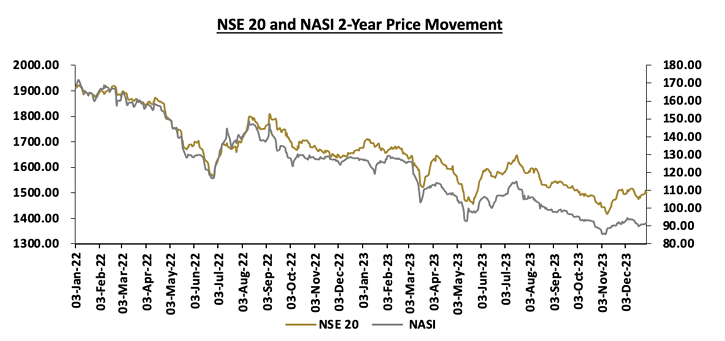
This performance was not a surprise. From our observations on market dynamics for nascent stock markets, price attrition across large-caps in bear cycles is not an anomaly. This is because a bulk of the overall market activity tends to be concentrated on a few blue chips, implying that shifts in market demand and supply will favor a case for discounted prices in bear cycles and premiums in bullish cycles.
From a broader market perspective, investor disposition in 2023 was in favor of risk-averse investments.
Notably:
i) Key local investors reallocated capital and skewed new injections toward fixed-income securities and offshore investments,
ii) The rising policy rates in developed markets implied two things. First, higher opportunity costs in frontier market investments for investors with exposure to developed markets. And second, a stronger dollar heightened currency risk for local currency investments. These, in our view, fueled capital flights in the bouse (that clocked the fourth consecutive year) as foreign investors’ preferences shifted to equities, fixed-income, and alternative investments in their home markets.
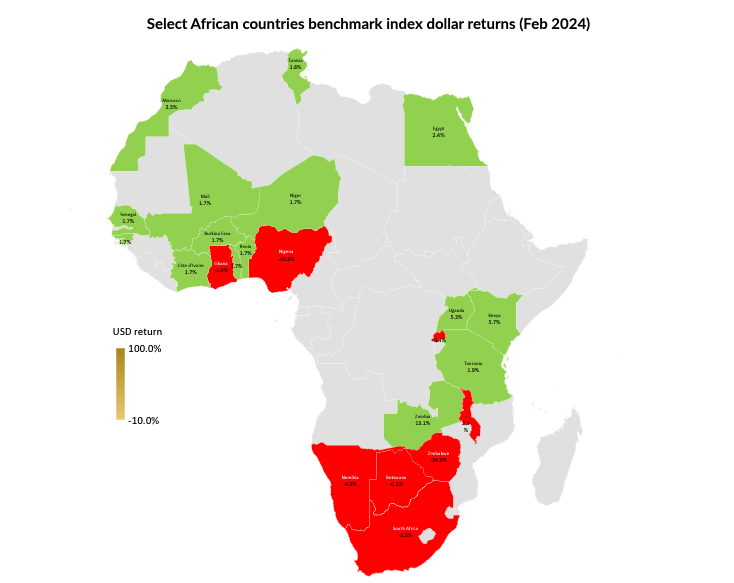
Looking ahead, we anticipate an upward reversal in pricing in 2024 (likely in 2H24) on the back of;
i. Fundamentals remain relatively strong across key sectors.
We expect the banking sector to continue raking profits from the perpetual demand for money (evinced by the strong Private Sector Credit Growth numbers) in the economy. This, coupled with the elevated lending rates, implies higher interest income for the industry, with tier one’s balance sheets best positioned to realize the bulk of the profitability.
We remain positive on diversification into broader financial offerings, which continue to boost non-funded income contribution to total revenues. Expansion outside the Kenyan market is expected to boost overall profitability at the group level and offset the balance sheet pressures of individual subsidiaries. Elevated unrealized losses and non-performing loans, however remain a near-term concern.
In Telecommunications, GSM trends suggest that data revenues will offset maturing voice and SMS revenue lines as 4G penetration deepens and reliance on over-the-top technologies takes root. That said, we expect to see a further softening in termination rates in the medium term for voice and SMS. But this does not worry us, given that mobile money revenues will tailwind overall topline growth. From our assessment, we opine that the sector will require additional spectrum allocations in the medium term to effectively service the growing user base and devices. The finite nature of the electromagnetic spectrum, however, suggests that the regulator may not be inclined to issue allocations to desired levels; thus efficient spectrum allocation strategies will be a defining factor for market players to maintain and grow market share in the long term.
In Manufacturing, we are cognizant of the price sensitivity and income elasticity in most sub-sectors, which is a drawback in elevated inflationary cycles. We, however, believe that disinflation may have a two-fold impact; first, improving demand, and second, causing a slowdown in input price pressures, in effect easing cash flow pressures and boosting overall profitability. Long-term concerns are in the legal and regulatory environment, more so in government tax policies, including the removal of certain exemptions, adjustments to payment timelines, and the introduction of new taxes such as the export and investment promotion levy, among others.
In Energy, system losses remain a key challenge in transmission, with the system efficiency declining by 0.6% in 2023 to 77.0%. The decline is attributable to electricity pilferage, grid constraints, and delays in the procurement of meters. The current installed capacity in the country is c. 3,165MW. With regards to generation KenGen accounts c. 60.2% of the installed capacity with an ambitious plan to inject c. 2.5 GW into the grid by 2030 – led by a 1.9GW geothermal mix. We believe power generation will remain healthy but transmission challenges may be a drag to the overall sector.
In Agriculture, we expect to see growth in production volumes on the back of expectations of favorable weather conditions in the year. The quantum growth is expected to partly offset softening prices in global markets for exporters of tea and coffee.
ii. Technicals speak of an upswing
The market underperformance in recent years was largely a result of investors adjusting their positions to global shocks. In 2020 for instance, the NASI closed the year down 8.6% which we believe was driven by the reallocation of portfolios in favor of cash and near-cash securities – in response to the uncertainties about the impact of the COVID-19 pandemic. 2021 was a testament to “less bad news is good news”. The market gained 9.4% with investors adjusting to the new normal before the impact surrounding the Russia-Ukraine crisis on global economies caused a double-digit fall in 2022 and 2023.
Understanding this complex interplay is key (at least for technical reasons) as 2024 is a year that seems to present investors with less bad news – ceteris paribus1. From a global play, potential rate cuts imply a likely capital reallocation to frontier markets. And since capital is shy, such inflows will likely be skewed towards blue chips. Second, a correction of the dollar seems imminent and we believe it will see local currencies gravitating to a position of stability – reducing currency risk exposure for international investors.
On pricing, mean reversion – which proposes that prices eventually revert to their long-term mean/ average levels – suggests that the deep discount levels (that are misaligned to fundamentals) are set for a reversal. We note that the market’s volatility over the past ten years2 has two outlier picks on the negative, that’s 20223 and 20234. From our statistical view, we believe there is a strong case for an upswing in 2024 driven by large caps thus we advise investors to remain invested in large caps as patience will be rewarded.
1Banking on no new developments that will heighten geopolitics risks
210-year medians: 7.86% coefficient of variation, -0.03 gradient
310.71% coefficient of variation, -0.12 gradient
411.57% coefficient of variation, -0.11 gradient
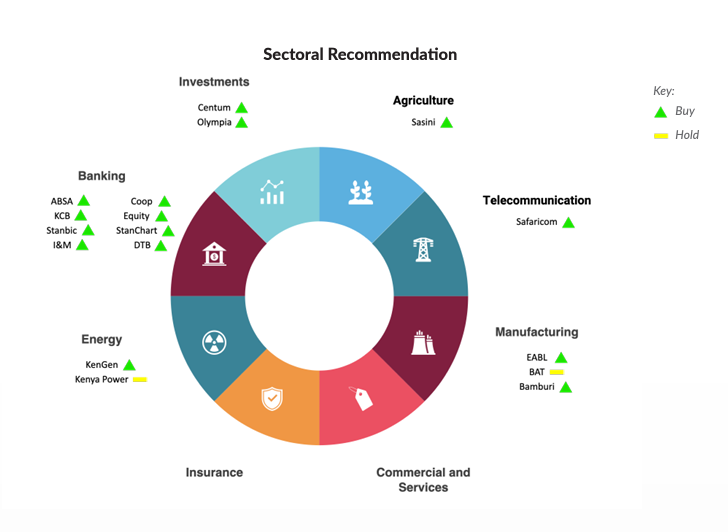
Global Markets: Recap of 2023 & Outlook
Deploy cautious optimism… Yogis aren’t smarter than average bears.
‘No matter how sophisticated our choices, how good we are at dominating the odds, randomness will have the last word.’
– Nassim Nicholas Taleb
We opine that investors are overly optimistic about the 2024 global market performance in part due to the upward revision of estimates following a surprise performance in 2023. Circling back, the 2023 global market performance was a wild card. First, economies coped rather well with the hawkish policy stance of key central banks – with global markets exceeding expectations in 2023. This was buoyed by the overall shift in investor sentiments from a c. 67% chance of a global recession at the start of the year to polarized altercations on the possibility of a soft landing at year-end.
Second, few expected oil prices to surprise on the downside despite OPEC+’s production cuts within the year and concerns about the potential disruption of oil supply from the Middle East conflict. Brent crude oil averaged at c. USD 83 per barrel in 2023 – down from c. USD 101 per barrel in 2022. This was, however, below the 2023 c. USD 95 per barrel estimate at the start of the year.
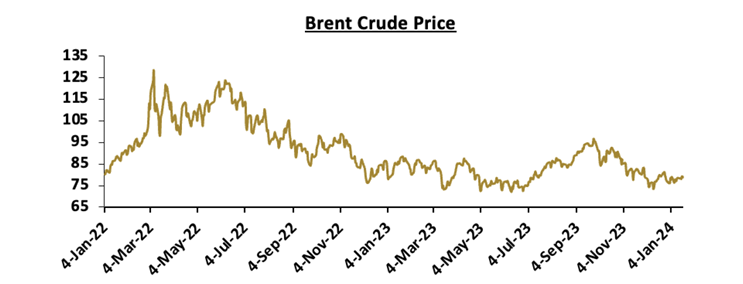
Still on commodities, a gold rally in 2023 received a tailwind from the geopolitical tensions, market uncertainty, elevated inflation, and pacing policy rates… gold, however, outpaced the average base-case estimate of c. USD 1,859/oz averaging the year at c. USD 1,943/oz. The outperformance was largely driven by two black swan events6. (i) Concerns around bank failures that saw gold break above the USD 2,000 mark in 2Q23, and (ii) Developments in the Middle East in 4Q23 that built momentum, seeing an intraday record high of c. USD 2,152/oz – both events lifted gold’s overall performance.
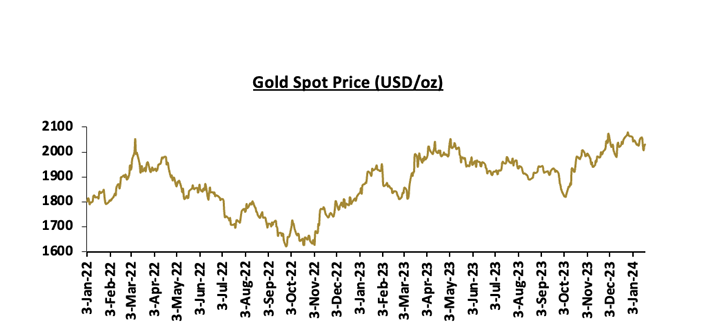
Third, the US Dollar smoothened off its 2022 highs albeit remaining at elevated levels – a win for analysts’ 2023 predictions of the US Dollar index7. The dollar’s strength was largely on the back of the hawkish Fed rate stance. Notably, the Fed hiked by a cumulative 100 basis points (bps) in 2023 – 25bps hikes in their February, March, May, and July meetings. This saw the Fed rate climb to 5.25% – 5.50% by year-end. The US dollar however weakened towards the tail end of the year in what we believe was investors being overly optimistic on the Fed signal of potential rate cuts in 2024.
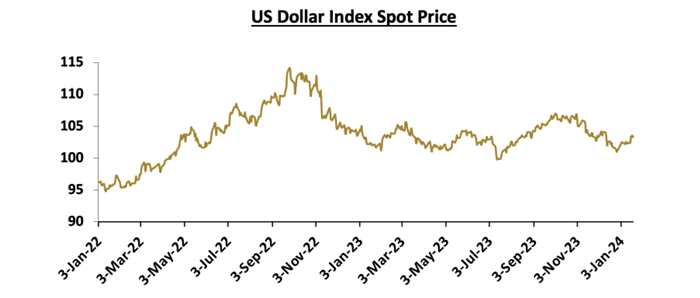
Finally, geopolitical risks remained disruptive with deepening trends that heightened cross-border international risks. Top on the list was the Russia-Ukraine conflict (now in its third year), entering its second year in February 2023, with the developments in the Middle East8 in 4Q23 raising the heat levels – further polarizing the world. Cybercrime remains a going concern… in economic crimes, e-commerce fraud, for instance, is expected to cost the global retail sector c. USD 48bn in 2023. Attacks on government agencies, on the other hand, continued to breach and sabotage key infrastructures – a threat to international relations and trade.
Continuing our narrative, the need for caveat emptor in the 2024 investment landscape cannot be overemphasized – as a mix of persistent headwinds will present investors with new uncertainties and uncommon opportunities. A momentous source of uncertainty, in our view, is the progressive impact of the policy rates. We see inflation in developed markets remaining erratic with the overall policy rates elevated in 2024 despite potential cuts.
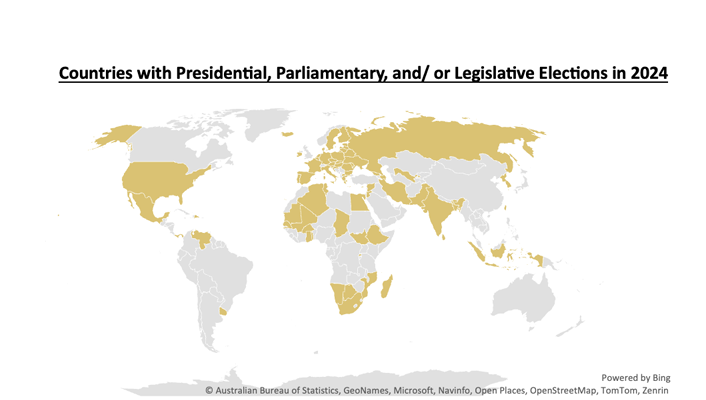
From policy to politics, about 60 countries will be heading to the polls in 2024 for local, regional, general, and/or presidential elections – that’s about half of the world population making up over 60% of the global economic output. The markets are expected to remain volatile on the back of speculations about the farreaching implications of individual national policy directions to international relations and trade.
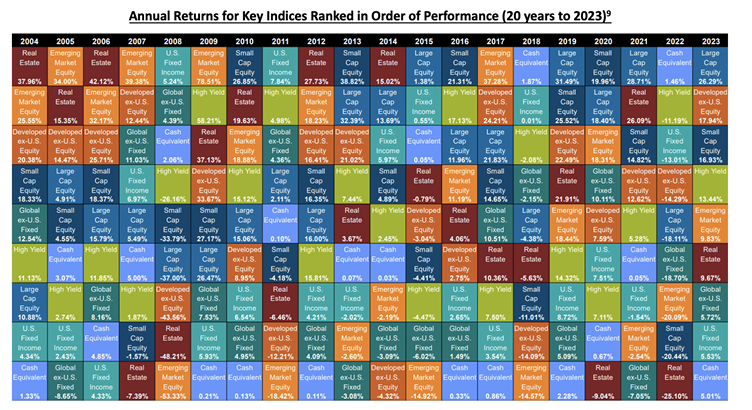
We opine the rise and developments in AI will intricate geopolitics10 in 2024 given its potential use-case for economic11 and military advancements. Our near-term concerns, however, are on the lack of a robust regulatory framework that may potentially lead to misuse and misinformation amidst growing public worry in a calendar year full of elections and heightened geopolitical tensions – further augmenting market risks.
We thus believe alpha12 will be hard in the year, and only investors who are nimble to adjust their cross-asset positions, approach market pricing with humility, and remain cautious of macro evolutions and geopolitical trends will outperform the markets.
In public equities, we advise investors to focus on quality and income picks within the large caps13 as they are best positioned to withstand higher rates and market uncertainty while maintaining decent earnings potential.
In private equity, we expect to see more transactions in 2024 as (i) About USD 1.3Tn in PE dry powder (the amount of committed but unallocated capital) is available for funding new deals, (ii) current valuations present opportunities to acquire top-tier assets at a discount, and (iii) the shifting macro dynamics are opening new markets for PE and venture capitals. We believe investments will be skewed toward tech given their disruptive nature with ESG remaining a key theme.
In fixed income, we advise investors to lock in yields currently on offer – more so in the developed markets investment grade (IG) government bonds. Bonds are crucial diversifiers against different risks and their role cannot be understated.
For investors with a higher risk tolerance, private credit presents an opportunity to boost overall portfolio returns. We anticipate that the current yields of IG private credit and sub-IG private credit coupled with their seniority in the cashflow waterfall will see a rise in investor demand within the year.
In alternatives, gold stands out as a strong commodity with a targeted pick of c. USD 2,300/oz. Finally, investors should wind down on cash as projected rate cuts from 2H24 will punish short-term interest rates as the pendulum swings towards rewarding duration.

For the 2023 review, please see our previous publications:
- NSE Summary performance for 2023, here
- Our debt outlook report, here
- 2023 Economic and Fixed Income market review, here
- 2023 outlook survey report, here
Disclosure and Disclaimer
Analyst Certification Disclosure: The research analyst or analysts responsible for the content of this research report certify that: (1) the views expressed and attributed to the research analyst or analysts in the research report accurately reflect their personal opinion(s) about the subject securities and issuers and/or other subject matter as appropriate; and, (2) no part of his or her compensation was, is or will be directly or indirectly related to the specific recommendations or views contained in this research report.
Global Disclaimer: Standard Investment Bank (SIB) and/or its affiliates makes no representation or warranty of any kind, express, implied or statutory regarding this document or any information contained or referred to in the document. The information in this document is provided for informational purposes only. It does not constitute any offer, recommendation or solicitation to any person to enter into any transaction or adopt any hedging, trading or investment strategy, nor does it constitute any prediction of likely future movements in rates or prices, or represent that any such future movements will not exceed those shown in any illustration. The stated price of the securities mentioned herein, if any, is as of the date indicated and is not any representation that any transaction can be effected at this price. While reasonable care has been taken in preparing this document, no responsibility or liability is accepted for errors of fact or for any opinion expressed herein. The contents of this document may not be suitable for all investors, as it has not been prepared with regard to the specific investment objectives or financial situation of any particular person. Any investments discussed may not be suitable for all investors. Users of this document should seek professional advice regarding the appropriateness of investing in any securities, financial instruments, or investment strategies referred to in this document and should understand that statements regarding future prospects may not be realised. Opinions, forecasts, assumptions, estimates, derived valuations, projections, and price target(s), if any, contained in this document are as of the date indicated and are subject to change at any time without prior notice. Our recommendations are under constant review. The value and income of any of the securities or financial instruments mentioned in this document can fall as well as rise, and an investor may get back less than invested. Future returns are not guaranteed, and a loss of original capital may be incurred. Foreign-currency denominated securities and financial instruments are subject to fluctuations in exchange rates that could have a positive or adverse effect on the value, price, or income of such securities and financial instruments. Past performance is not indicative of comparable future results, and no representation or warranty is made regarding future performance. While we endeavour to update on a reasonable basis the information and opinions contained herein, there may be regulatory, compliance, or other reasons that prevent us from doing so. Accordingly, information may be available to us which is not reflected in this material, and we may have acted upon or used the information prior to or immediately following its publication. SIB is not a legal or tax adviser and is not purporting to provide legal or tax advice. Independent legal and/or tax advice should be sought for any queries relating to the legal or tax implications of any investment. SIB and/or its affiliates may have a position in any of the securities, instruments, or currencies mentioned in this document. SIB has in place policies and procedures and physical information walls between its Research Department and differing business functions to help ensure confidential information, including ‘inside’ information, is not disclosed unless in line with its policies and procedures and the rules of its regulators. Data, opinions, and other information appearing herein may have been obtained from public sources. SIB makes no representation or warranty as to the accuracy or completeness of such information obtained from public sources. You are advised to make your own independent judgment (with the advice of your professional advisers as necessary) with respect to any matter contained herein and not rely on this document as the basis for making any trading, hedging, or investment decision. SIB accepts no liability and will not be liable for any loss or damage arising directly or indirectly (including special, incidental, consequential, punitive, or exemplary damages) from the use of this document, howsoever arising, and including any loss, damage, or expense arising from, but not limited to, any defect, error, imperfection, fault, mistake, or inaccuracy with this document, its contents, or associated services, or due to any unavailability of the document or any part thereof or any contents or associated services. This material is for the use of intended recipients only, and in any jurisdiction in which distribution to private/retail customers would require registration or licensing of the distributor, which the distributor does not currently have, this document is intended solely for distribution to professional and institutional investors.



